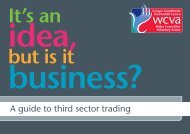Measuring Impact - Nicva
Measuring Impact - Nicva
Measuring Impact - Nicva
You also want an ePaper? Increase the reach of your titles
YUMPU automatically turns print PDFs into web optimized ePapers that Google loves.
Assessing the impact of regeneration projects 29<br />
5.2.2 Interviews and analysis<br />
Following agreement with the project managers and partnership co-ordinators, interviews<br />
were held with project managers and key stakeholders for each organisation. These included<br />
intended beneficiaries, local residents and activists, volunteers, staff, project managers of<br />
other SRB-funded projects, and other funders. Not all stakeholders were specific to one<br />
particular project: local residents, local authority and London Development Agency (LDA)<br />
staff for example. Interviewees were selected based on availability and suitability. Contact<br />
details for further potential interviewees were obtained at many of the interviews (particularly<br />
the interviews with project managers).<br />
A total of 28 interviews, lasting between half an hour and one and a half hours, were carried<br />
out. Most were individual interviews, but in some cases it made sense to interview two or<br />
three people in an informal group situation. Many interviews took place in the interviewees’<br />
work places. In the case of volunteers, they were carried out informally on-site, or in the<br />
interviewees’ own homes. Some local residents and volunteers involved in the Lansbury<br />
Festival were interviewed in the informal setting of the post-festival celebratory party. Three<br />
local residents were accessed via a local New Deal provider.<br />
Interviews were loosely structured and varied depending on the interviewee. This allowed the<br />
greatest opportunity to identify the full range of impacts. Importantly, there was no particular<br />
emphasis on anticipated impacts.<br />
Questions were asked based on a number of themes, most of which were common to all interviews.<br />
New themes arising during interviews were used to inform subsequent interview schedules,<br />
resulting in a fuller and more comprehensive interview schedule. Broad themes included:<br />
• social capital (linking 7 , bridging 8 and bonding 9 );<br />
• long-term/future impact and sustainability;<br />
• impact on and relationship with other organisations, including members of the<br />
partnership and other funders;<br />
• negative impact;<br />
• other current impacts, including skills, enjoyment, environmental improvements,<br />
and changes in attitudes.<br />
Interviewees were also asked about their perception of the system or network in which the<br />
organisations operate, and to represent their perception of the system diagrammatically,<br />
explaining the roles and relationships within the system. In addition, some local resident<br />
interviewees were asked to circle on a map the area where they lived. The map was then left<br />
on the table so that interviewees could refer to it throughout the interview.<br />
Analysis was carried out on an ongoing basis, so that subsequent interviews could be<br />
amended accordingly. The transcribed interviews were then coded according to themes.<br />
7 Linking social capital: the connections between individuals and groups in hierarchical or power-based relationships<br />
such as national and local government.<br />
8 Bridging social capital: the links or relationships between people from different groups or networks.<br />
9 Bonding social capital: the strong ties and close relationships within homogeneous groups.












